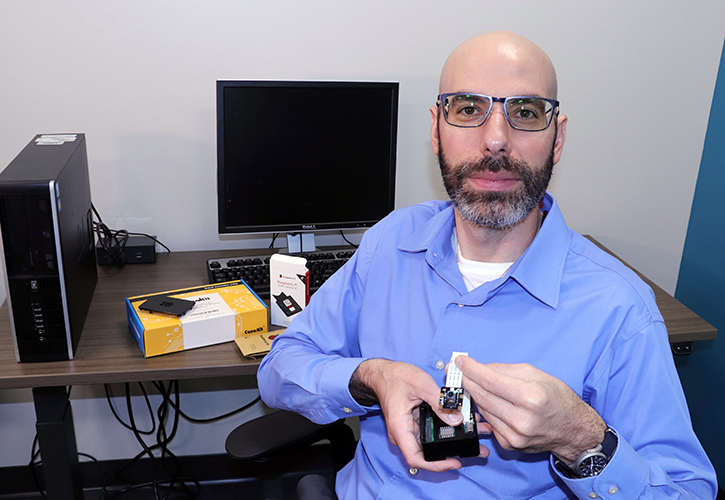College of Arts and Sciences Newsroom

UD researchers design new approach to operating systems courses with $300K NSF grant
By Dave Larsen
Computer operating systems continue to develop rapidly to meet the needs of powerful desktops, smartphones and internet-connected appliances, but college courses for future programmers haven’t always kept pace.
With a $299,308 National Science Foundation (NSF) grant, two University of Dayton researchers designed new approaches for operating systems courses that engage students in active learning. Their model has been made publicly available for free to undergraduate computer science and engineering degree programs at institutions worldwide.
“The NSF didn’t give us this grant just to design a new course at UD,” said Saverio Perugini, professor of computer science. “They really wanted us to build a national model that could be transferable and replicable at other universities.”
The course, Operating Systems, was developed and evaluated over three years by Perugini, the project’s principal investigator, and David Wright, director of academic technology and curriculum innovation. They collaborated with John C. Gallagher, a former Wright State University professor of computer science.
Operating systems courses prepare students for upper-level computer sciences courses such as artificial intelligence, robotics and cyber security.
“Those are the sexy courses, but they all need operating systems to align with what they do,” said Wright, a co-principal investigator. “So, whatever career path students take, they need this as a foundational course to be successful.”
The course goes beyond desktop systems to also include mobile operating systems and the “internet of things” — devices such as motion sensors and health monitors that connect and exchange data over wireless networks. It is intended to resolve significant issues of misalignment between existing operating systems courses and employee professional skills and knowledge requirements.
The three-year grant, awarded in 2017, was extended through 2021 because of the pandemic lockdown. The researchers used a portion of the funding to purchase 50 Raspberry Pi computers — small, single-board devices — to provide students with hands-on programming experience. For example, students could connect a small camera to the Raspberry Pi and write code to control the camera.
“It was largely driven by the students programming the Raspberry Pi’s and altering their functionality remotely through the network, which is sort of another signal that operating systems are a very different animal in this day and age,” Wright said. “This course has really helped students see that firsthand by trying it themselves in the classroom.”
Working with faculty from the Department of Computer Science and the Department of Geology and Environmental Geosciences, Perugini and Wright developed more than 30 active learning laboratories with 180 students during six semesters. Gallagher piloted the pedagogical approaches at Wright State.
The labs were compiled into a 300-page online manual that Perugini has shared with a “community of practice” he built by collecting faculty contact information at computer science workshops and conferences. Those instructors can adopt the entire model or adapt certain aspects of it into their own courses.
“In computer science, things move so fast that it’s really time-consuming to create lecture plans, project plans and laboratory plans,” Perugini said. “The faculty we talked to found significant value in the plug-and-play motif of the lab manual and how they could use it in their teaching activities, primarily because this was just ready to go.”
Institutions whose faculty have used or expressed interest in using Perugini’s model in their teaching include Massachusetts Bay Community College, Centre College in Kentucky, Southwest Baptist University in Missouri and Utrecht University in the Netherlands.
In addition to the online manual, the NSF grant resulted in about a dozen journal, conference paper and abstract publications to date, including many with undergraduate students listed as co-authors, as well as a variety of conference demonstrations and tutorials.
Perugini said the grants also helped the University establish its Center for Cyber Security and Data Intelligence, and supported its case to be designated as a National Center of Academic Excellence in Cyber Defense by the National Security Agency and U.S. Department of Homeland Security.
“Re-conceptualizing this course this way, plus the grant, definitely supported our case for UD becoming an NSA National Center of Excellence,” he said.
For more information, visit the Operating Systems online manual or the Department of Computer Science website.
Photo: Saverio Perugini, a professor of computer science at UD, holds a Raspberry Pi computer with a camera attached.
